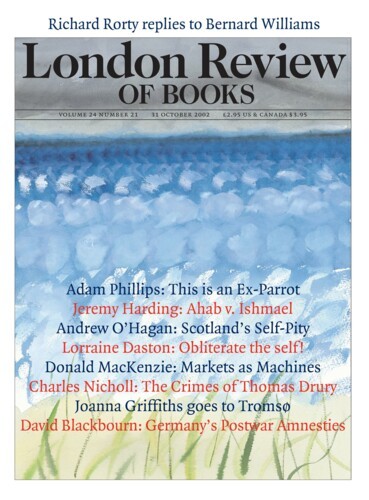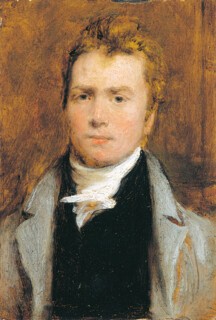David Wilkie, 20 years old, a sober, modest son of the manse, came to London from Edinburgh in 1805. He brought with him a couple of pictures, a sound training and great diligence. In 1806 he exhibited The Village Politicians at the Academy to great acclaim. Scotland had produced a Dutch talent – a Teniers or an Ostade. In the first decade of his career in London he painted, and made good money from, pictures of this sort: for Sir George Beaumont The Blind Fiddler; for the financier John Julius Angerstein (who paid 800 guineas) The Village Holiday; for the Prince Regent Blind Man’s Buff (finished 1813). Wilkie became an associate and then a member of the Royal Academy while very young; he was knighted and made a painter to the King. He was well-rewarded as a portraitist.
Personally he was unprepossessing. This Self-Portrait (1813) sent to his brother in India shows a contained, serious concentration which fits with accounts of an outwardly shy man, who liked better to stand by than to join in. He suffered from periods of depression – one, when he was in his forties, so bad that he was persuaded by his doctor to make a belated Grand Tour. He never married and died on his way back from a journey to the East, where he was looking for authentic detail for Biblical subjects. Turner, ever the competitor, had at one point been spurred by the younger man’s success into trying to outdo him in the domestic/rustic genre: now he did a painting of Wilkie’s burial at sea.
Bright detail and a sweet touch draw you towards the small to middling sized pictures he made before about 1822. They encourage you to jostle your way to the front, to get close enough to the canvas to read gestures, textures and expressions. It was not just popularity that made it necessary to rope off Chelsea Pensioners, receiving the London Gazette extraordinary of Thursday, June 22nd 1815, Announcing the Battle of Waterloo!!! when it was shown in the Royal Academy (it was commissioned by the Duke of Wellington in 1816, but shown there in 1822). To see the picture from a distance was not to see it properly. Wilkie’s was the first painting to demand such protection from the Academy crowds. Later in the century Frith’s scenes of modern life on the beach, at the races, in the railway station, all full of figures and incident, also had to be fenced off.
The physical qualities of paintings from the first phase of Wilkie’s career are treated cruelly by reproduction. Print cannot record the liveliness of the paint surface. The pictures tend to die on the page and enlarged details make things look clumsy which, seen face to face, are magically precise. The exhibition in Dulwich until 1 December is quite small, but big enough to judge him by. I would guess that more than half the important pictures from his first phase are there. The Chelsea Pensioners was his masterpiece – or so it seemed to his contemporaries. It marked the end of the run of detailed narrative paintings. In later, larger pictures in which his admiration for Old Masters – in particular Rembrandt and Murillo – becomes apparent, his ability to record the understated emotions of everyday life is lost. Take the look on the face of the young wife whose husband is thinking of the price of the cloth a pedlar is showing her. Nicholas Tromans, in his catalogue essay, writes: ‘Wilkie’s contemporaries valued his early work as dearly as any British art has ever been cherished, but it remains for us to recognise and appreciate what he went on to achieve.’* We can try, but it can be a bit of a struggle.
The labour involved in painting small should not be ignored. Millais, whose stroke was not as fluent and agreeable as Wilkie’s, gave up Pre-Raphaelite detail and, like Wilkie, turned to the profitable business of portraiture. In our time Lucian Freud found the shift from little brushes to big ones a relief. In Wilkie’s case the sheer effort and time which went into one detailed painting may have told, but a look at his early work invites other thoughts. First, just as the late pictures show him reaching for the effects other men achieved, so it is necessary to look further afield than Holland for apt comparisons with the early ones. Wilkie, who knew the Dulwich Gallery, much admired the Watteau there. His touch – in particular his way with fabric – is much more French than Dutch. His sentimental comedies are neither as artful (in the organisation of figures) nor as highly articulated as those of Greuze, but they are in many ways more convincing. The drunken man in The Village Holiday being pulled towards home by his womenfolk and back to the alehouse by his companions makes a sophisticated composition – something out of a Rubens kermesse – but the drama has more of life about it and less of the stage.
The catalogue essays quote liberally from contemporary reviews. These remind you how much there can be to read in a picture. Consider The Penny Wedding. Across the floor onto which the bridegroom leads his bride to join the dancers is a table where people sit and eat. There a man reaches up to remove his black bonnet – a prelude to saying grace. The bonnet, central to the composition but covering no area worth speaking of, had seemed to me an accent of black – grace hadn’t entered my head. As much as the arrangement of the figures, the suggestion that this is a godly as well as a cheerful gathering is what separates it from Dutch pictures in the same genre. There is, too, the matter of colour. One must put oneself back into a world where only paintings reproduced the colours of the natural world to understand the attention given to the representation of light – day, lamp or fire – in contemporary notices. For us, the Caravaggesque lighting of a picture of Savoyards arrested by a village constable, painted shortly after the Chelsea Pensioners, seems no more than a glance towards a stronger kind of illumination. Yet at the time it was badly received because it seemed over-dramatic. Again contemporary critics weren’t always happy with the domestic paraphernalia piled (in the Dutch manner) in the foreground or on a side table in many of these pictures. Nobility and simplicity – the virtues of the Old Masters – seemed through most of the 19th century wretchedly difficult to achieve.
The desire to reach beyond the everyday was one reason to try on Rembrandt or Murillo’s styles. But in Wilkie’s case it seems also to reflect a habit of personal self-improvement by imitation, of believing that the best way to make something new was first to borrow something old. It makes it difficult to focus on his personality. Among his drawings, where an artist’s personal handwriting is usually most obvious, one finds details of costume, composition studies in Rembrandt-like shorthand and even Oriental studies which probably owe something to J.F. Lewis (Wilkie met him on his travels).
How far this elusive personality had to do with being Scottish is a matter for debate. His genre paintings, after he came to London, are not strongly Scottish in their detail (as a Lowlander he was unhappy that the kilt and plaid were being treated as national costume). His ability to handle natural poses and natural light, to efface his own personality and not to over-project the personalities of others might, at a pinch, be found in other Scottish painters (Raeburn comes to mind) in whose work the skill with a brush precludes the need for those displays of individuality which differentiate (for example) the strong but sometimes inept moral lessons of Hogarth from Wilkie’s slyer, less emphatic commentaries.
Send Letters To:
The Editor
London Review of Books,
28 Little Russell Street
London, WC1A 2HN
letters@lrb.co.uk
Please include name, address, and a telephone number.


